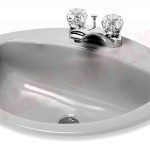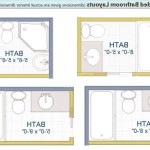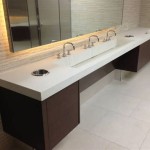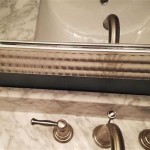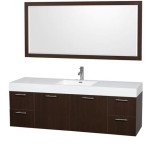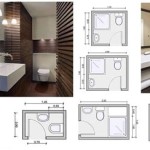Bathroom Above Sink Cabinets: Optimizing Space and Style
Bathroom design often presents a challenge of balancing functionality with aesthetics, particularly in smaller spaces. Above-sink cabinets offer a practical solution, providing valuable storage while contributing to the overall style of the bathroom. These cabinets come in a variety of styles, sizes, and materials, allowing homeowners to customize their bathroom to suit their specific needs and preferences.
Choosing the right above-sink cabinet involves careful consideration of several factors, including the size and layout of the bathroom, the existing style elements, and the intended storage needs. A well-chosen cabinet can significantly improve the organization and usability of the bathroom space, while also enhancing its visual appeal.
Key Point 1: Types and Styles of Above-Sink Cabinets
Above-sink cabinets are available in a range of types, each offering unique benefits and aesthetic qualities. Understanding these differences is crucial for selecting the most appropriate option for a particular bathroom.
Medicine Cabinets: Commonly recessed into the wall, medicine cabinets offer a streamlined appearance and typically feature mirrored doors. They are ideal for storing smaller items such as medications, toiletries, and personal care products. Recessed models maximize space by minimizing protrusion into the room. Some medicine cabinets also include electrical outlets or USB ports for added convenience.
Surface-Mounted Cabinets: These cabinets are attached directly to the wall, making them easier to install than recessed models. Surface-mounted cabinets are available in various styles, from simple and functional designs to more decorative options with intricate detailing. They often provide more storage space than recessed medicine cabinets, making them suitable for larger bathrooms or individuals with extensive storage needs.
Open Shelving Cabinets: Combining open shelving with enclosed cabinet space allows for a blend of display and concealed storage. Open shelves are ideal for showcasing decorative items or frequently used toiletries, while enclosed cabinets provide discreet storage for less visually appealing items. This type of cabinet can add visual interest and create a more dynamic bathroom design.
Corner Cabinets: Designed to fit into the corner of a bathroom, these cabinets are an effective way to utilize otherwise wasted space. Corner cabinets can be particularly useful in smaller bathrooms where maximizing storage is essential. They are available in both wall-mounted and floor-standing versions, providing flexibility in terms of installation and storage capacity.
Floating Shelves with Cabinets: This option combines the minimalist aesthetic of floating shelves with the practicality of enclosed cabinets. The shelves provide easy access to frequently used items, while the cabinets offer concealed storage for clutter. This combination can create a modern and uncluttered look in the bathroom.
The style of the above-sink cabinet should complement the overall aesthetic of the bathroom. Options range from traditional designs with ornate detailing to contemporary styles with clean lines and minimalist hardware. The choice of materials, finishes, and hardware can significantly impact the cabinet's appearance and its integration with the existing bathroom décor. Consider matching the cabinet hardware to other fixtures in the bathroom, such as faucets and towel bars, for a cohesive look.
Key Point 2: Material and Construction Considerations
The material and construction of an above-sink cabinet significantly impact its durability, appearance, and resistance to moisture. Bathrooms are inherently humid environments, making moisture resistance a critical factor in cabinet selection.
Wood: Solid wood cabinets offer a classic and timeless appeal. However, solid wood is susceptible to warping and damage from moisture exposure. When using wood in a bathroom, it is essential to choose a species known for its moisture resistance, such as cedar or teak, and to apply a protective sealant or finish. Properly sealed wood cabinets can add warmth and character to the bathroom.
Plywood: A more affordable alternative to solid wood, plywood offers good stability and resistance to warping. It is typically used for the cabinet's frame and interior components. High-quality plywood with multiple layers is preferable for bathroom cabinets due to its increased strength and durability. Ensure the plywood is sealed properly to prevent moisture penetration.
Medium-Density Fiberboard (MDF): MDF is a manufactured wood product that is smooth and easy to paint. It is often used for cabinet doors and drawer fronts. While MDF is less expensive than solid wood or plywood, it is more susceptible to water damage. When using MDF in a bathroom, it is crucial to seal it thoroughly and to avoid prolonged exposure to moisture.
Laminate: Laminate cabinets consist of a thin layer of decorative material bonded to a substrate, such as plywood or MDF. Laminate is durable, easy to clean, and resistant to scratches and stains. It is available in a wide range of colors and patterns, making it a versatile option for bathroom cabinets. However, laminate can be susceptible to chipping or peeling if not properly applied or maintained.
Metal: Metal cabinets offer a sleek and modern aesthetic. They are durable, moisture-resistant, and easy to clean. Stainless steel is a popular choice for bathroom cabinets due to its resistance to corrosion and its contemporary appearance. Metal cabinets can add an industrial or minimalist touch to the bathroom.
The construction of the cabinet is equally important. Look for cabinets with solid joints, sturdy hinges, and smooth drawer glides. Dovetail joints are a sign of high-quality craftsmanship and provide superior strength. Soft-close hinges and drawer glides prevent slamming and extend the life of the cabinet. The interior shelves should be adjustable to accommodate items of different sizes.
Key Point 3: Installation and Placement Considerations
Proper installation and placement of an above-sink cabinet are crucial for ensuring its functionality, safety, and aesthetic appeal. Careful planning and attention to detail are essential for a successful installation.
Height: The height at which the cabinet is installed will depend on the height of the sink and the users' needs. Generally, the bottom of the cabinet should be positioned at least 4 to 8 inches above the sink. This allows for adequate clearance for faucets and other fixtures, while also providing comfortable access to the cabinet's contents. Consider the height of the tallest users in the household to ensure the cabinet is accessible to everyone.
Width and Depth: The width of the cabinet should be proportionate to the size of the sink and the surrounding space. A cabinet that is too wide can overwhelm the area, while a cabinet that is too narrow may not provide sufficient storage. The depth of the cabinet should also be considered, particularly in smaller bathrooms. A shallow cabinet will minimize protrusion into the room, maximizing usable space.
Lighting: Integrating lighting into or around the cabinet can significantly enhance its functionality and visual appeal. Under-cabinet lighting provides task lighting for activities such as applying makeup or shaving. Recessed lighting above the cabinet can highlight its features and create a more inviting atmosphere. Consider using LED lighting, which is energy-efficient and long-lasting.
Accessibility: Ensure that the cabinet is easily accessible to all users, including those with mobility limitations. The door swing should not obstruct access to the sink or other fixtures. Consider using pull-down shelves or other assistive devices to improve accessibility for individuals with disabilities.
Wall Structure: Before installing the cabinet, verify that the wall is structurally sound and capable of supporting its weight. Locate wall studs and use appropriate mounting hardware to secure the cabinet to the studs. If installing a recessed medicine cabinet, ensure that there are no electrical wires or plumbing pipes in the wall that could be damaged during installation.
Installation of an above-sink cabinet can be a DIY project for experienced homeowners. However, for those unfamiliar with plumbing or electrical work, it is recommended to hire a qualified professional. A professional installer can ensure that the cabinet is installed safely and correctly, minimizing the risk of damage or injury.
By carefully considering the types, styles, materials, construction, installation, and placement of above-sink cabinets, homeowners can effectively optimize their bathroom space and create a functional and stylish environment. The right cabinet can transform a cluttered and disorganized bathroom into a well-organized and visually appealing space.

Bathroom Medicine Cabinet Over Toiled And Sink Pin By Jodi Petit On Millie Bath Remodeli Cabinets Designs Design Custom

Bathroom Furniture Cabinets Units Shelves The Range
:strip_icc()/101117359-59dd243b83324c7aba23379dd8d46d0e.jpg?strip=all)
23 Gorgeous Bathroom Vanity Solutions To Fit Every Style

24 Black Modern Bathroom Vanity With Faucet Medicine Cabinet And Linen Side Option
:strip_icc()/101803909-a324b6e72aac40d9be1a1bc1a0bb66bc.jpg?strip=all)
23 Gorgeous Bathroom Vanity Solutions To Fit Every Style

Over The Toilet Storage And Design Options For Small Bathrooms

Pin On For The Home

Bathroom Updates Organization Printable Balancing Home

Marble Shelf Above Bathroom Sink Design Ideas

Bathroom Vanity Styles To Fit Your Space Forbes Home
